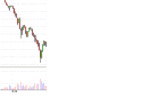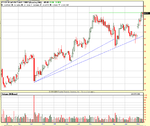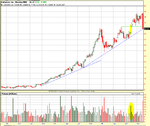Mr. Charts
Legendary member
- Messages
- 7,370
- Likes
- 1,200
Hiya Tim and Lee,
As I said in post 612, I stuck with my one minute exit rules.
So, why didn't I get out on the retracement for "fear" of losing money already earned?
Have a look at the volume on the retracement, it's much less than on the two previous down candles so there was little strength in the retracement; hence it was likely to turn out to be a retracement, not a reversal.
How did I know the volume was going to be less at the time?
My micro-analysis on level 2 showed me the price going up on significantly less volume - at the time - in front of my eyes. Hence the probability was high the move was a retracement, not a reversal. Had that changed in front of my eyes I would have closed out the position - in other words I would have acted in accordance with the evidence in front of me, not out of "fear".
I feel the emotion as we all do, but I can subsume it under the weight of evidence.
Not my opinion, the evidence.
Those of you who know my one minute rules also know they are subject to micro-analysis.
Look at the screen shot I took at exit in the post a couple of days ago. I exited near the bottom of the move. Not at it, but not too far away. Why? Because I could see on micro-analysis there was more buying coming in although the selling hadn't abated - the volume going through was increasing sharply plus certain market participants were changing their stance. I could see all the hallmarks of a volume blow off BEFORE it happened.
This micro-analysis is invaluable to me. Amongst many other things it enables me to see what is happening and its strength as it starts to develop, BEFORE it shows up on a candle or a volume bar.
Another thing, large moves have large retracements.
I think you need to look at things in the context of the whole range of the move. It's not a matter of intestinal fortitude, more the nature of the stock price move - horses for courses.
I have just scrolled back through esignal and taken an image including volume to illustrate some of what I mean.
Hope that helps.
Richard
As I said in post 612, I stuck with my one minute exit rules.
So, why didn't I get out on the retracement for "fear" of losing money already earned?
Have a look at the volume on the retracement, it's much less than on the two previous down candles so there was little strength in the retracement; hence it was likely to turn out to be a retracement, not a reversal.
How did I know the volume was going to be less at the time?
My micro-analysis on level 2 showed me the price going up on significantly less volume - at the time - in front of my eyes. Hence the probability was high the move was a retracement, not a reversal. Had that changed in front of my eyes I would have closed out the position - in other words I would have acted in accordance with the evidence in front of me, not out of "fear".
I feel the emotion as we all do, but I can subsume it under the weight of evidence.
Not my opinion, the evidence.
Those of you who know my one minute rules also know they are subject to micro-analysis.
Look at the screen shot I took at exit in the post a couple of days ago. I exited near the bottom of the move. Not at it, but not too far away. Why? Because I could see on micro-analysis there was more buying coming in although the selling hadn't abated - the volume going through was increasing sharply plus certain market participants were changing their stance. I could see all the hallmarks of a volume blow off BEFORE it happened.
This micro-analysis is invaluable to me. Amongst many other things it enables me to see what is happening and its strength as it starts to develop, BEFORE it shows up on a candle or a volume bar.
Another thing, large moves have large retracements.
I think you need to look at things in the context of the whole range of the move. It's not a matter of intestinal fortitude, more the nature of the stock price move - horses for courses.
I have just scrolled back through esignal and taken an image including volume to illustrate some of what I mean.
Hope that helps.
Richard





